Yongchao Feng
Vision-Language Model for Object Detection and Segmentation: A Review and Evaluation
Apr 13, 2025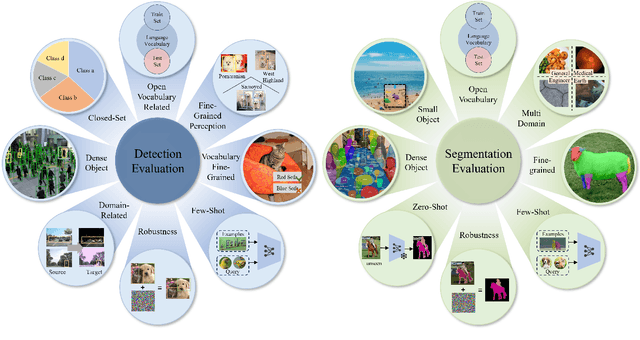
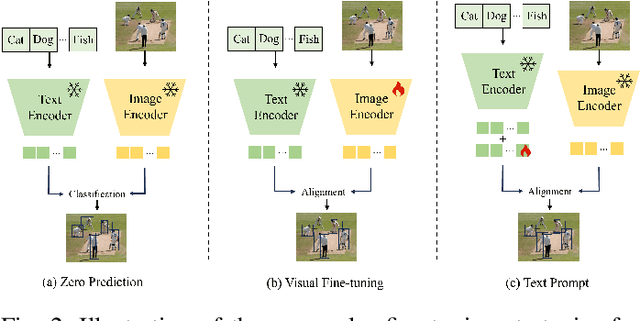
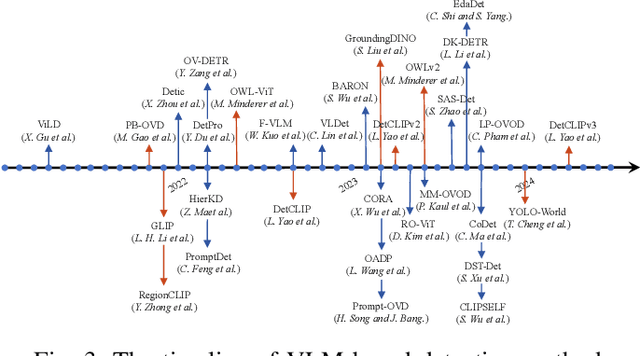
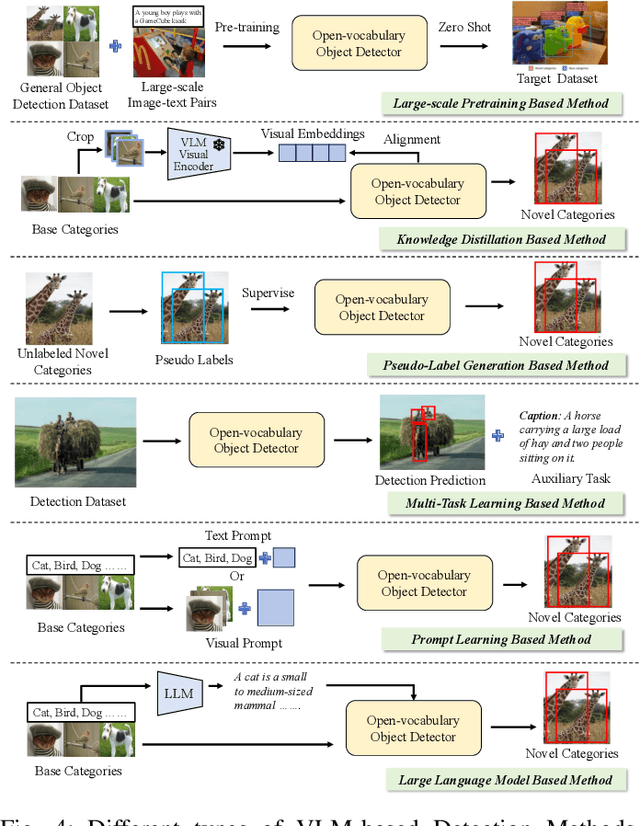
Abstract:Vision-Language Model (VLM) have gained widespread adoption in Open-Vocabulary (OV) object detection and segmentation tasks. Despite they have shown promise on OV-related tasks, their effectiveness in conventional vision tasks has thus far been unevaluated. In this work, we present the systematic review of VLM-based detection and segmentation, view VLM as the foundational model and conduct comprehensive evaluations across multiple downstream tasks for the first time: 1) The evaluation spans eight detection scenarios (closed-set detection, domain adaptation, crowded objects, etc.) and eight segmentation scenarios (few-shot, open-world, small object, etc.), revealing distinct performance advantages and limitations of various VLM architectures across tasks. 2) As for detection tasks, we evaluate VLMs under three finetuning granularities: \textit{zero prediction}, \textit{visual fine-tuning}, and \textit{text prompt}, and further analyze how different finetuning strategies impact performance under varied task. 3) Based on empirical findings, we provide in-depth analysis of the correlations between task characteristics, model architectures, and training methodologies, offering insights for future VLM design. 4) We believe that this work shall be valuable to the pattern recognition experts working in the fields of computer vision, multimodal learning, and vision foundation models by introducing them to the problem, and familiarizing them with the current status of the progress while providing promising directions for future research. A project associated with this review and evaluation has been created at https://github.com/better-chao/perceptual_abilities_evaluation.
OpenRSD: Towards Open-prompts for Object Detection in Remote Sensing Images
Mar 08, 2025Abstract:Remote sensing object detection has made significant progress, but most studies still focus on closed-set detection, limiting generalization across diverse datasets. Open-vocabulary object detection (OVD) provides a solution by leveraging multimodal associations between text prompts and visual features. However, existing OVD methods for remote sensing (RS) images are constrained by small-scale datasets and fail to address the unique challenges of remote sensing interpretation, include oriented object detection and the need for both high precision and real-time performance in diverse scenarios. To tackle these challenges, we propose OpenRSD, a universal open-prompt RS object detection framework. OpenRSD supports multimodal prompts and integrates multi-task detection heads to balance accuracy and real-time requirements. Additionally, we design a multi-stage training pipeline to enhance the generalization of model. Evaluated on seven public datasets, OpenRSD demonstrates superior performance in oriented and horizontal bounding box detection, with real-time inference capabilities suitable for large-scale RS image analysis. Compared to YOLO-World, OpenRSD exhibits an 8.7\% higher average precision and achieves an inference speed of 20.8 FPS. Codes and models will be released.
PACF: Prototype Augmented Compact Features for Improving Domain Adaptive Object Detection
Jan 15, 2025Abstract:In recent years, there has been significant advancement in object detection. However, applying off-the-shelf detectors to a new domain leads to significant performance drop, caused by the domain gap. These detectors exhibit higher-variance class-conditional distributions in the target domain than that in the source domain, along with mean shift. To address this problem, we propose the Prototype Augmented Compact Features (PACF) framework to regularize the distribution of intra-class features. Specifically, we provide an in-depth theoretical analysis on the lower bound of the target features-related likelihood and derive the prototype cross entropy loss to further calibrate the distribution of target RoI features. Furthermore, a mutual regularization strategy is designed to enable the linear and prototype-based classifiers to learn from each other, promoting feature compactness while enhancing discriminability. Thanks to this PACF framework, we have obtained a more compact cross-domain feature space, within which the variance of the target features' class-conditional distributions has significantly decreased, and the class-mean shift between the two domains has also been further reduced. The results on different adaptation settings are state-of-the-art, which demonstrate the board applicability and effectiveness of the proposed approach.
MutDet: Mutually Optimizing Pre-training for Remote Sensing Object Detection
Jul 13, 2024

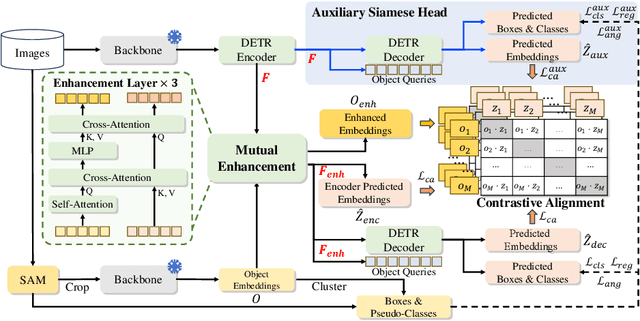

Abstract:Detection pre-training methods for the DETR series detector have been extensively studied in natural scenes, e.g., DETReg. However, the detection pre-training remains unexplored in remote sensing scenes. In existing pre-training methods, alignment between object embeddings extracted from a pre-trained backbone and detector features is significant. However, due to differences in feature extraction methods, a pronounced feature discrepancy still exists and hinders the pre-training performance. The remote sensing images with complex environments and more densely distributed objects exacerbate the discrepancy. In this work, we propose a novel Mutually optimizing pre-training framework for remote sensing object Detection, dubbed as MutDet. In MutDet, we propose a systemic solution against this challenge. Firstly, we propose a mutual enhancement module, which fuses the object embeddings and detector features bidirectionally in the last encoder layer, enhancing their information interaction.Secondly, contrastive alignment loss is employed to guide this alignment process softly and simultaneously enhances detector features' discriminativity. Finally, we design an auxiliary siamese head to mitigate the task gap arising from the introduction of enhancement module. Comprehensive experiments on various settings show new state-of-the-art transfer performance. The improvement is particularly pronounced when data quantity is limited. When using 10% of the DIOR-R data, MutDet improves DetReg by 6.1% in AP50. Codes and models are available at: https://github.com/floatingstarZ/MutDet.
DUA-DA: Distillation-based Unbiased Alignment for Domain Adaptive Object Detection
Nov 17, 2023
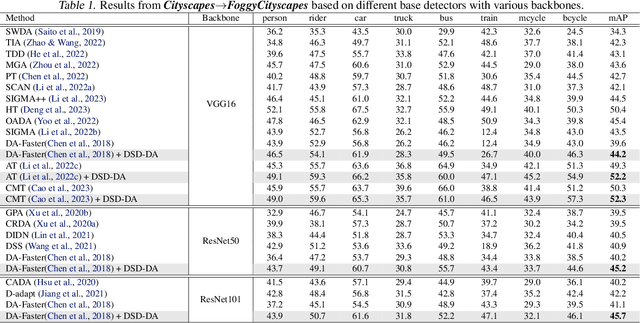
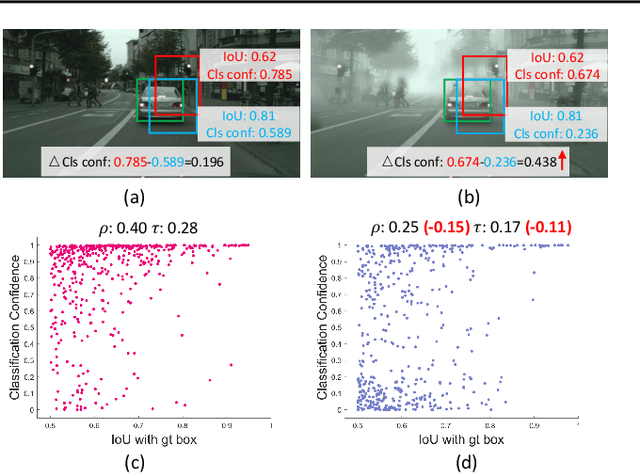
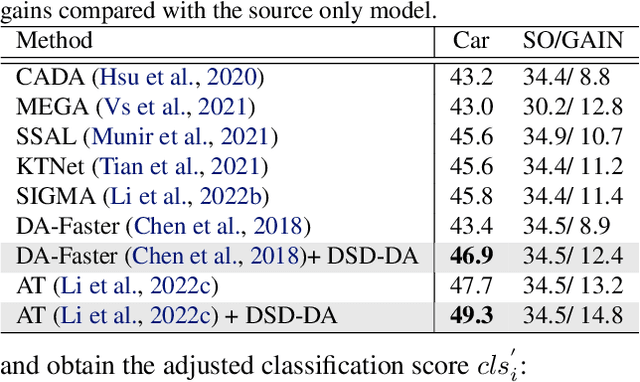
Abstract:Though feature-alignment based Domain Adaptive Object Detection (DAOD) have achieved remarkable progress, they ignore the source bias issue, i.e. the aligned features are more favorable towards the source domain, leading to a sub-optimal adaptation. Furthermore, the presence of domain shift between the source and target domains exacerbates the problem of inconsistent classification and localization in general detection pipelines. To overcome these challenges, we propose a novel Distillation-based Unbiased Alignment (DUA) framework for DAOD, which can distill the source features towards a more balanced position via a pre-trained teacher model during the training process, alleviating the problem of source bias effectively. In addition, we design a Target-Relevant Object Localization Network (TROLN), which can mine target-related knowledge to produce two classification-free metrics (IoU and centerness). Accordingly, we implement a Domain-aware Consistency Enhancing (DCE) strategy that utilizes these two metrics to further refine classification confidences, achieving a harmonization between classification and localization in cross-domain scenarios. Extensive experiments have been conducted to manifest the effectiveness of this method, which consistently improves the strong baseline by large margins, outperforming existing alignment-based works.
 Add to Chrome
Add to Chrome Add to Firefox
Add to Firefox Add to Edge
Add to Edge